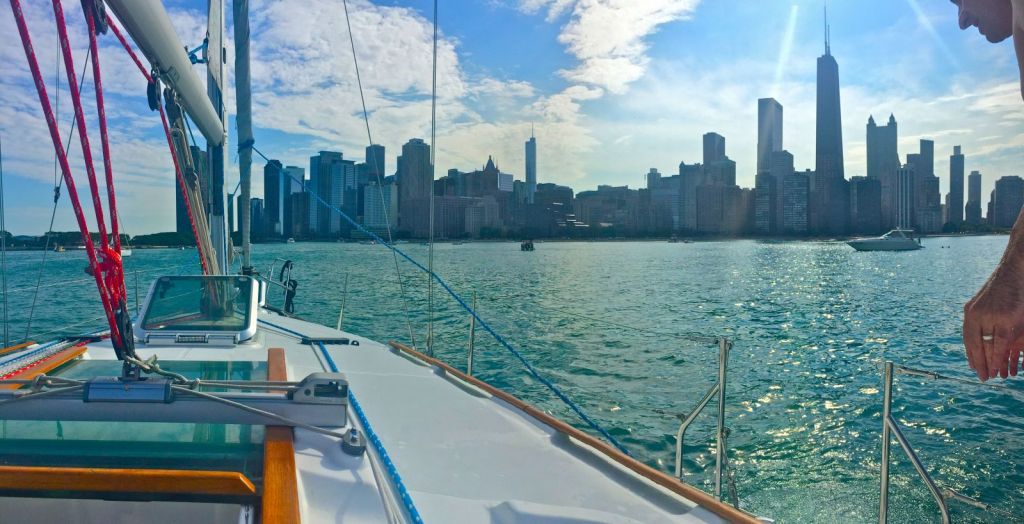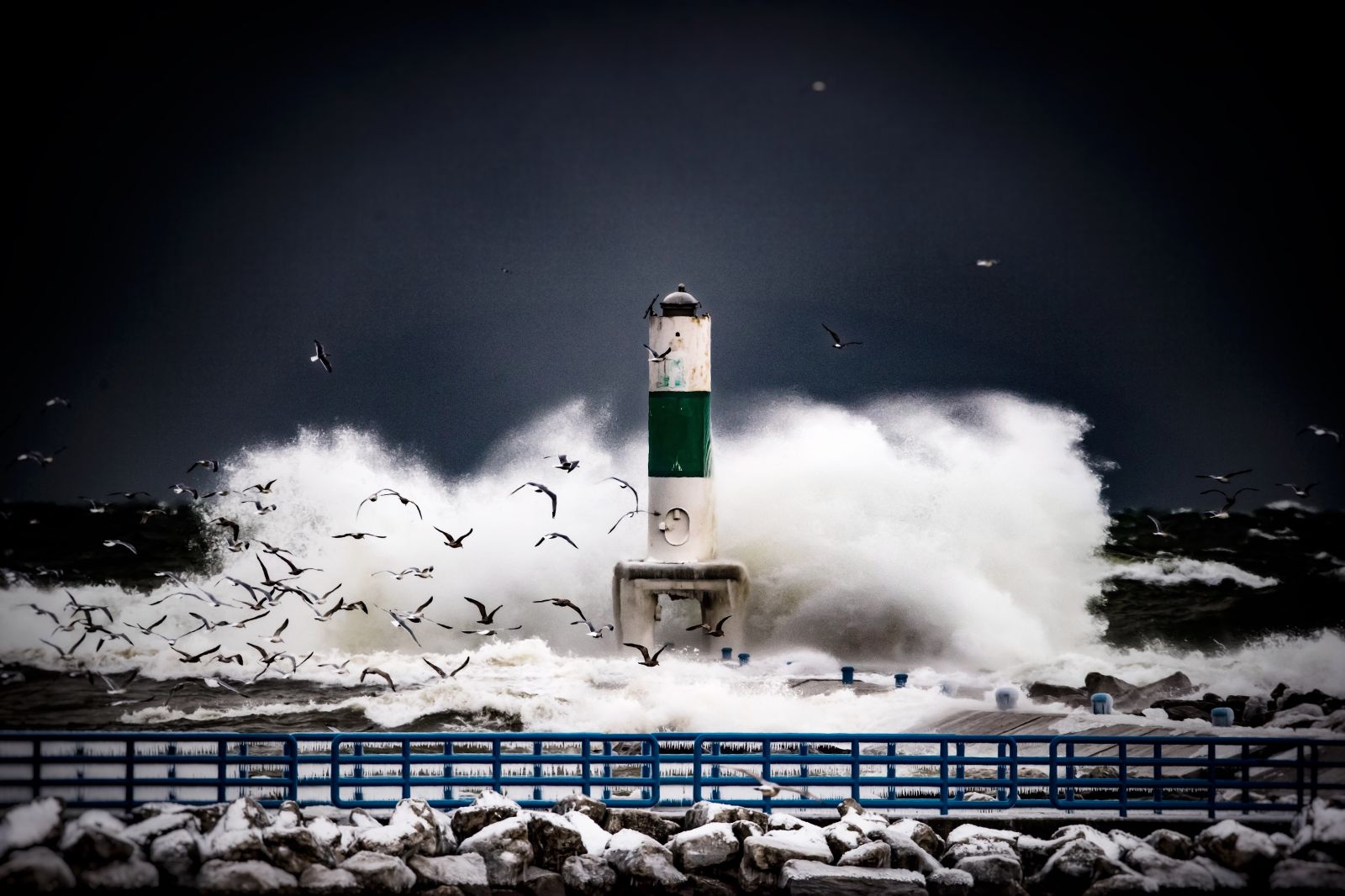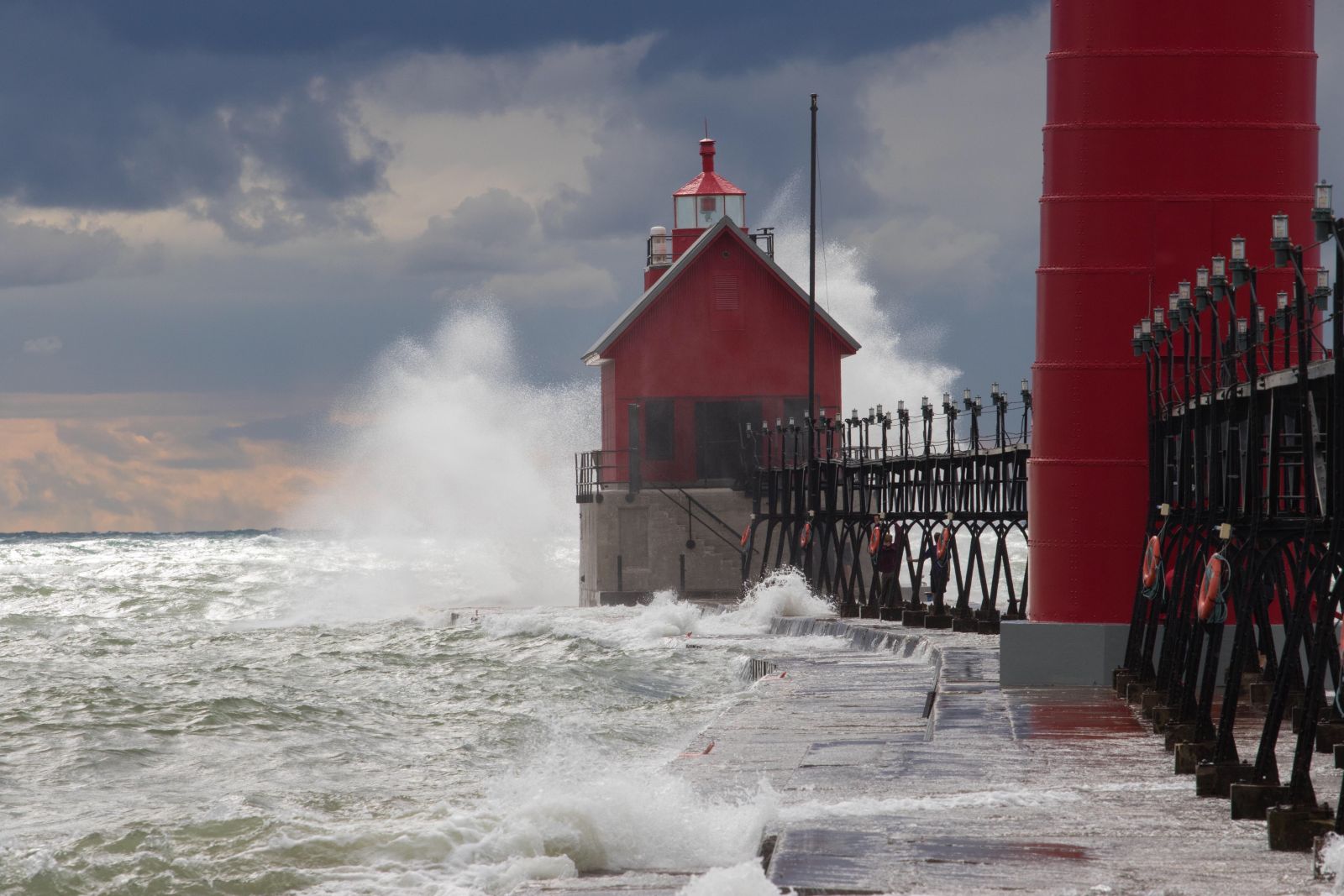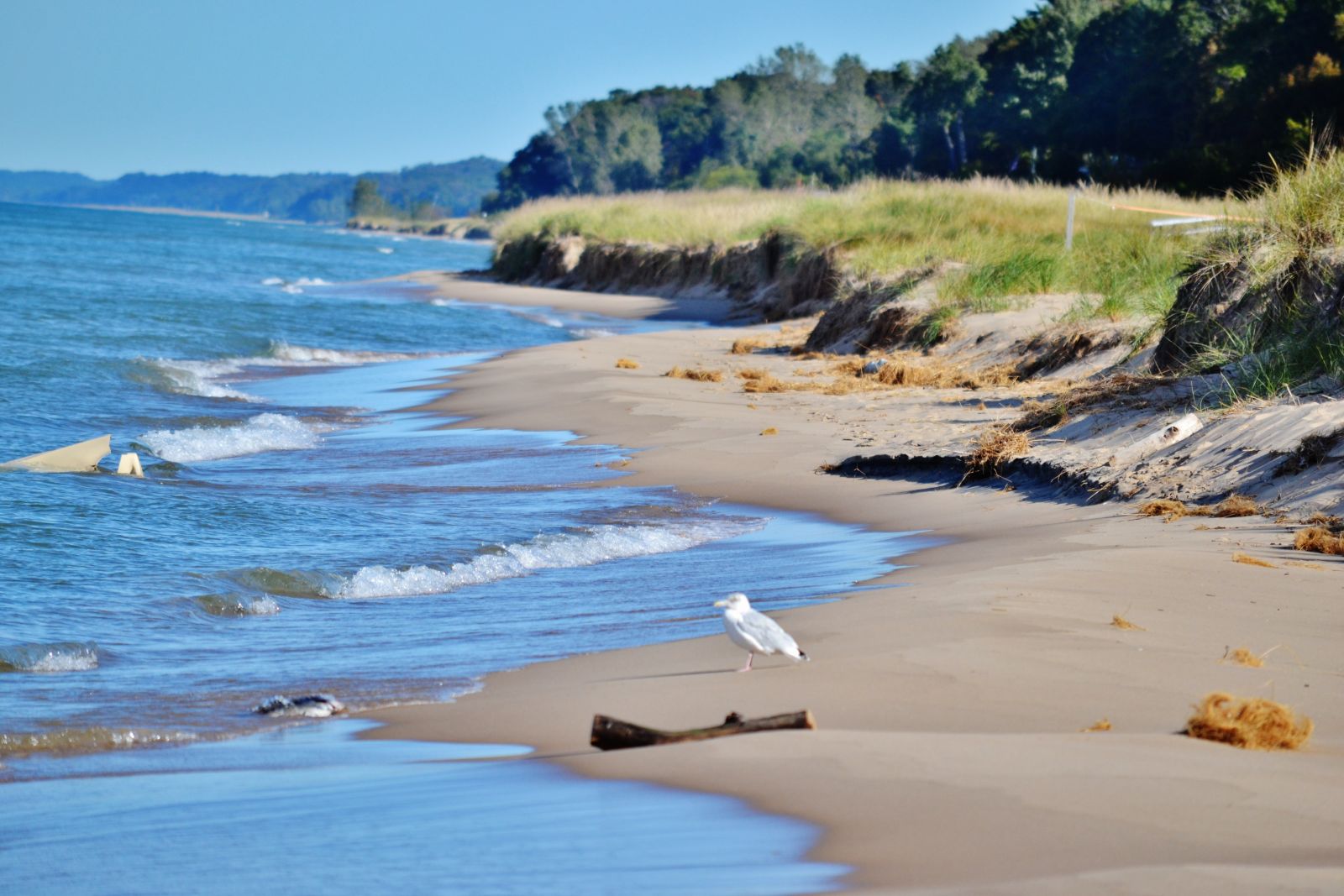11 Sailor Tips for Sailing Lake Michigan (with Distances)
Lake Michigan has clear, blue waters that can come as a surprise to many first time sailors. If you’re planning to sail on Lake Michigan, it’s worth getting some inside tips before you go so you know what to expect and what to avoid!
Top Sailor Tips for Sailing Lake Michigan:
- What size sailboat is best for Lake Michigan?
- What are the sailing conditions on Lake Michigan?
- When is the best time to sail on Lake Michigan?
- Does Lake Michigan have tides?
- How big are the waves on Lake Michigan?
- What to wear for sailing on Lake Michigan?
- What are the biggest hazards when sailing on Lake Michigan?
- Sailing from Chicago to New Buffalo
- Sailing from Lake Michigan to Lake Huron
- Sailing from Chicago to Detroit
- Sailing from Lake Michigan to the Gulf of Mexico
Read on for the best answers to the most commonly asked questions on sailing on Lake Michigan.

What size sailboat is best for Lake Michigan?
The ideal sailboat size will depend on how many people you plan to have on board and how long you’ll be spending on your boat. As a standard sailboat for Lake Michigan, you should ideally look at 27-feet or longer. Something like a Catalina 30 is a great choice for the Great Lakes. Ideally, you’re not looking for anything too big and a boat with a shallow draft to cope with shallower regions on the lakes.

What are the sailing conditions on Lake Michigan?
Lake Michigan is a 300 mile (494km) long freshwater lake. It is the third largest of the Great Lakes, with a surface area of 22,300 square miles or 58,000 km squared.
You can sail on Lake Michigan from mid-May to mid-October. Generally, the water temperature stays low until late June and early July. As a result of midwest weather patterns, the winds get less predictable during August and early September.
Squalls tend to be common and can present a challenge to smaller boats. The wind pattern and velocity on Lake Michigan can also get quite high which can lead to big waves. The changeability of the conditions means a storm can quickly roll in before calming just a few hours later. Summer thunderstorms can be particularly dangerous and are difficult to predict.
It is easy to get hold of detailed local forecasts for wind and weather so use them to judge when it’s best to go out. The winds on Lake Michigan are usually predictable well in advance so they’re easy enough to avoid. That being said, it’s wise to stick to the coast until you’re confident you have a good understanding of the conditions as they can change quickly. Common sense is your best guide.

When is the best time to sail on Lake Michigan?
Sailing on Lake Michigan is nicest when the temperature starts to climb but before the warmer temperatures start to unsettle the weather patterns. This means that the best time to sail is around mid-summer, between June and July.
Whatever time of year you sail on Lake Michigan, be prepared to have some days off the water. It’s not unusual to be hit by bad weather even during the summer months. Another thing to bear in mind is that it tends to get cold on the water at night so make sure you have cold weather gear with you.
Does Lake Michigan have tides?
The Great Lakes are considered to be non-tidal but nonetheless, Lake Michigan does have fluctuations in its water levels. There are twice daily tides on Lake Michigan of approximately 0.5 to 1.5 inches (around 1 to 4 cm).
Such fluctuations caused by the gravitational pull of the sun and moon have very little effect when compared with the changes caused by wind and air pressure, however. These create the most noticeable shifts in the level of Lake Michigan.
Similarly, the Bay of Green Bay on Lake Michigan experiences the most significant tidal shifts thanks to the local geography. In this region, levels on Lake Michigan can fluctuate up to 4 inches (approximately 10 cm)

How big are the waves on Lake Michigan?
The wave heights on Lake Michigan vary significantly according to the wind. As Lake Michigan is not open ocean, its wave heights are limited by the fetch. The highest waves on Lake Michigan are around 20-25 feet in height, which is about 6-7.5 meters. 20 foot waves are generally rare but not unheard of.

What to wear for sailing on Lake Michigan?
As the temperatures on Lake Michigan can stay cool until mid-summer, it’s a good idea to have layers of wind and cold protection with you. Even when the water begins to warm, it stays cold beneath the surface so consider wearing a wetsuit.
Thermal and fleece layers will also provide you with good insulation even when wet. You may will also need waterproof clothing in case you get caught in a thunderstorm (though these are best avoided!) and lifejackets.
If you’re sailing on Lake Michigan, it is not uncommon to have flies bothering you, some of which bite. With this in mind, you might want to opt for long sleeves and long trousers in lighter colors to avoid being bitten. Alternatively, you could use insect repellant and reapply often.
What are the biggest hazards when sailing on Lake Michigan?
Lake Michigan is a stunning sailing destination but it’s not without its hazards. The shifting wind and water conditions can quickly catch you off guard. It’s not uncommon for sailors to be heaved overboard. Make sure all life jackets and wet suits are fitted with reflective tapes and you have whistles and flares.
Though water levels in Lake Michigan are rising, the water has also been known to recede to record low levels in recent decades. Check the current water levels before you go out and be aware of submerged objects close to the surface at low water levels.
You also need to be vigilant, even when sailing in good weather, as squalls can start quickly. If you’re going to be sailing at night, it is vital to have a powerful night light on board in order to be seen from a distance by other vessels, especially in fog, and to aid navigation.
Lastly, there will be ships on Lake Michigan that are far larger than your sailboat. Pay attention to your surroundings, especially on commercial shipping routes.

Sailing routes & distances
Sailing across Lake Michigan can involve a huge range of different routes, either going offshore or along the coast
Sailing from Chicago to New Buffalo
Chicago and New Buffalo are situated almost directly opposite one another. To sail directly across Lake Michigan, from Chicago to New Buffalo, is a distance of approximately 40 nautical miles straight sailing. The journey can take between 2-5 hours. The exact time will depend on the conditions on the lake and the speed of your sailboat.
Sailing from Lake Michigan to Lake Huron
Lake Michigan and Lake Huron are joined by a 5 mile wide (8 km) channel known as the Straits of Mackinac. Lake Huron is 206 miles long and 183 miles wide with an average depth of 195 ft.
To get to Lake Huron from Lake Michigan, you will pass under The Mackinac Bridge, one of the longest suspension bridges in the world. You will also sail past The Beavers - a collection of islands in the north of Lake Michigan - and Mackinac Island. Both are brilliant stopping points on your journey!
To sail from Chicago on Lake Michigan to Alpena on Lake Huron, the route is approximately 440 nautical miles. At a steady rate of 8 knots, the route would take roughly 2-3 days to complete.
Sailing from Chicago to Detroit
Sailing from Chicago to Detroit involves crossing from Lake Michigan into Lake Huron. There is also the added challenge of sailing down the St Clair River, leaving Port Huron and making the way to Walpole Island, coming out into Lake St Clair.
Detroit lies across the lake and a short way down the Detroit River. It is approximately 630 nautical miles from Chicago to Detroit.
Sailing from Lake Michigan to the Gulf of Mexico
If you’re sailing to the Gulf of Mexico, the Mississippi River is the most sensible route for exiting the Great Lakes. You’ll sail downstream from southern Lake Michigan via the Chicago River, entering the Des Plaines River.
The Illinois River will take you to the Mississippi River, just north of St. Louis, Missouri. You can choose to stay on the Mississippi River, going south past Memphis, Tennessee and Greenville Mississippi. This route takes you out near New Orleans, Louisiana.
Alternatively, a more popular route is to go from the Mississippi River, up the Ohio River and to the Tennessee River, coming back down in a loop through the Tennessee-Tombigbee Waterway, or the Ten-Tom Waterway. The Ten-Tom Waterway is a nice inland water route and this journey is very well travelled, forming part of ‘The Great America Loop’.
Sailing the inland waterways from the Great Lakes to the Gulf of Mexico is approximately 1,530 miles.
Did you find the answer to your specific question?
👍 10 👎 3


Leave a comment